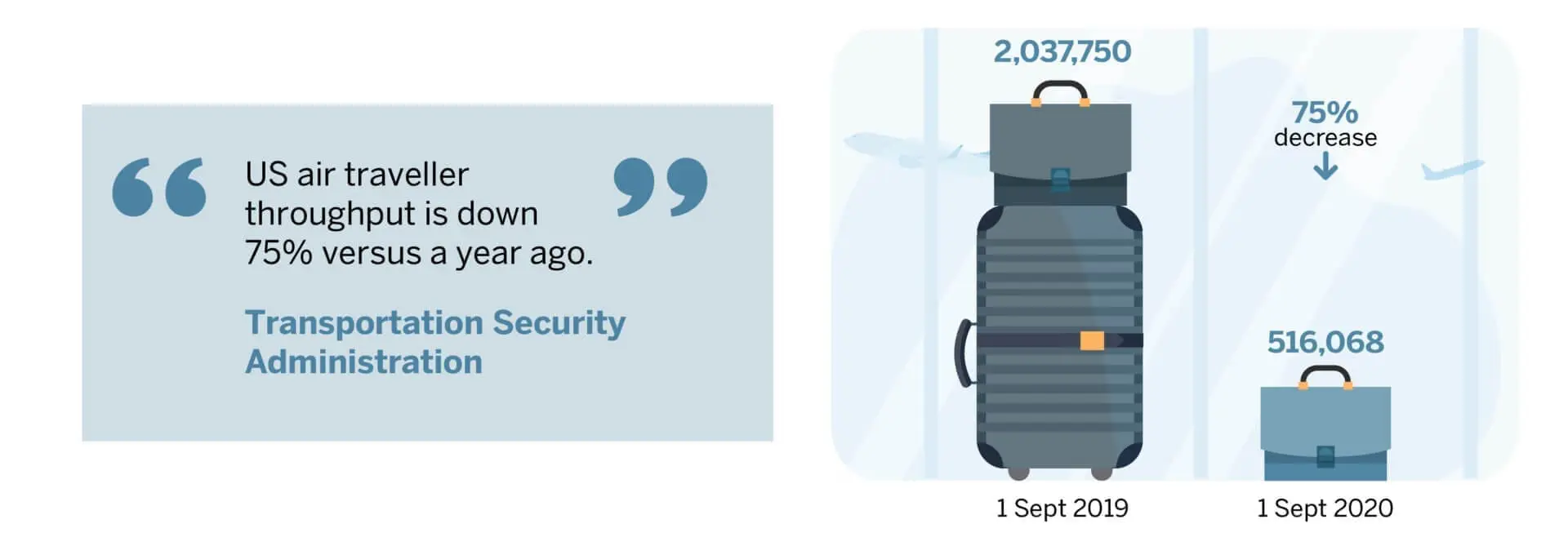Among the biggest anticipated shifts is a significant, and potentially long-term, reduction in both international and domestic high-margin business travel. Although, at the time of writing, leisure travel has gained momentum, one expert interviewed by Third Bridge Forum predicts that a considerable portion of business revenue will be lost indefinitely. “If business revenue goes down 5-10%… that will impact supply, it will impact networks, things like that, and it’s pretty easy to see that happening,” the former JetBlue Airways Corp executive said. Even if a vaccine becomes available, business travel may not return to pre-pandemic levels, which could prove problematic for the industry given business travellers represent a significant chunk of industry revenues. For example, 35% of Delta Air Lines’ revenue comes from business class tickets.
Adding to the problem, many knowledge-based businesses have adapted to working from home full-time. In the US, major tech companies have led the charge while, in the UK, fund manager Schroders became the first major City firm to make home working permanent in mid-August. With this shift in full swing it’s easy to imagine that one day intercontinental business trips may be a thing of the past, particularly when a Zoom video call can be almost as effective. Moreover, this period has prompted many people to reevaluate their work-life balance, resulting in a reduced appetite for unnecessary travel and commuting. “That’s the concern for the airlines longer term… if the habits of business travel begin to change, that changes their economics, and if it changes their economics they need to change their cost structures to react appropriately,” an executive at AirInsight Group, LLC added.
With fewer flights and passengers, airlines are being forced to rethink their hub structures, as some routes become increasingly unprofitable owing to lagging passenger numbers. Figures released by the Transportation Security Administration show that as at Tuesday 1 September 2020 total traveller throughput totalled 516,068, compared with 2,037,750 a year earlier. Many short-haul routes in particular are under pressure. A former American Airlines managing director sees Los Angeles International (LAX), California, and Phoenix, Arizona, as serving limited roles for that airline under the current circumstances because they complete the network “for a market that no longer exists.” For example, Asia to LA and vice versa is a depressed market at present while LAX “stands out the most because it’s so competitive, it’s so expensive”, a former project leader at Delta Air Lines said.

For most US carriers, the break-even load factor, without CARES funding, is 70-80%. But with aircraft operating at 50% capacity at present, the future looks bleak. “Some markets are actually filling aircraft, whereas, in other markets, airlines are not breaking even remotely, and, at some point, the airlines will need to consider whether or not to cut some of those markets,” a former Southwest Airlines manager said.
As airlines’ networks shrink and funding remains uncertain, bankruptcies could follow, although none of the major US airlines have yet found themselves in this situation. The former Delta executive believes there is scope for further industry consolidation, with JetBlue a “prime takeover target” as a relatively small, high-end carrier. “They’re at that 20-year inflection point where costs are going to go up, but they don’t have the revenue of a strong international network with the big business class seats, yet, to offset that,” he said. The specialist also predicts that airlines will gravitate more towards joint ventures and away from alliances, such as Star Alliance, which involves over 20 carriers. The emphasis on collaboration in joint ventures leads to stronger integration and greater mutual benefits, he said. “That trite saying of, ‘One plus one equals three,’ I think really applies here.”
A vaccine, albeit by no means a silver bullet, is the airline industry’s best bet for recovery. One of the aforementioned experts predicts that the lasting impacts of COVID-19 will lead to a drop in travel revenue as a percentage of US GDP, as was also the case in the years following 9/11. “It’s difficult to tell where things are going until we get a better handle on the disease, but we do know it’s not going to be a fast recovery for international travel and we do know that there will be some substitution from technology for business travel that will impact airline yields and revenues pretty significantly,” another specialist said, adding that international and domestic flight volumes are unlikely to recover until 2025 and 2024 respectively. Similarly, the former American Airlines executive predicts that it will take 24-36 months for the airline industry to return to 2019’s passenger and flight levels.
This is undeniably the first time the industry has experienced such a prolonged impact at such magnitude. However, it remains “incredibly competitive,” according to the former Delta executive. The JetBlue-American Airlines partnership announced in July is a testament to this. In one Interview, it was observed that the slowdown has in fact allowed airlines to “refocus and step back from the hectic, fast-paced movement of the industry”. This period has also meant they’ve had the chance to reassess some of their strategies and fleets, and reevaluate their five-year goals, it was noted.
With that said, the consensus is that COVID-19’s impact on the airline industry is going to manifest in myriad ways for years to come. We face the prospect of a smaller industry with less financial flexibility, fewer flights and higher fares. Other considerations include the future of fleets and associated manufacturing, how airports are being impacted by and responding to the pandemic, and what might be on the cards from an innovation perspective as airlines attempt to win back market share.
The information used in compiling this document has been obtained by Third Bridge from experts participating in Forum Interviews. Third Bridge does not warrant the accuracy of the information and has not independently verified it. It should not be regarded as a trade recommendation or form the basis of any investment decision.
For any enquiries, please contact sales@thirdbridge.com



